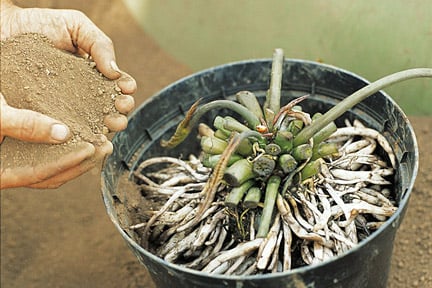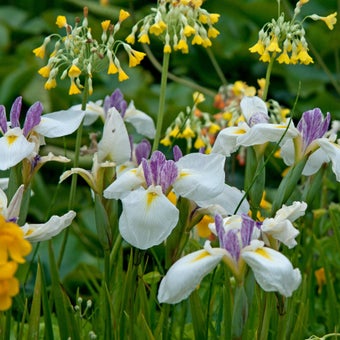
Quick facts
Suitable for - Any pond plant
Timing - Mid-spring to early summer
Difficulty - Moderate
When to plant aquatics
Mid-spring through to early summer is the best time to purchase new plants. This is a good time to plant, as the water is warming up and plants should establish well.
Planting aquatics
Before you begin to plant, you will need the following:
Containers: In smaller ponds, aquatic plants benefit from being grown in containers as this helps prevent them becoming too large and . Proprietary containers (aquatic baskets) usually have lattice sides to allow water, air and other gas movement. Unless they have a very fine mesh, they should be lined with hessian or polypropylene fabrics to prevent soil washing out from the container.
Soil: suitable for planting aquatic plants should be a medium to heavy loam. Garden soil can be used if it is free from fertiliser and herbicides. Otherwise, a proprietary aquatic compost should be used (this may contain a slow-release fertiliser that won’t seep out into the water).
How to plant
- Choose an appropriate container for the size of the plant
- For stability, particularly for taller plants, large rocks and stones may need to be placed in the base of containers
- Part-fill the container with compost
- Plants should be planted to the same depth as in the original container. However, plants with are positioned so the rhizomes are just above the soil’s surface. Firm plants in well
- Apply a thin layer of grit or fine gravel to prevent fish from stirring up the soil
Different plants for different places
Different plants are adapted to grow in different locations in and around the pond. It is best to choose the right one for the location you have in mind so that they are successful.
Deep water aquatics
These can be bought as container-grown or bare-rooted plants. Container-grown plants may need potting into larger containers. Bare-rooted plants should have old roots and large leaves removed before planting. Newly planted containers may need to be raised on bricks so the plants are not too deep and any leaves that float on the surface are not submerged. They are then lowered in stages as their leaves reach the surface, until the appropriate depth is reached.
Floating plants
Introduce floating aquatics to the pool by placing them gently on the water’s surface. Clumps may need separating first. One plant per square metre of surface area should be sufficient. Avoid floating plants, see our advice aquatic weeds for further information.
Marginals
Marginals are grown on the inside edge of the pond, or in a bog garden. If bought in plastic pots or small baskets, replant into aquatic baskets. When planting bare-rooted plants in summer, trim back the tops by half and trim the roots back to within 2.5cm (1in) of the crown.
Submerged aquatics
Oxygenating plants can be purchased in bunches and are planted into baskets. They will need anchoring firmly in place. Approximately four to five bunches, each containing three to four stems, per square metre of water surface should be sufficient. As these plants at night, too many can lead to a lack of oxygen at night during the summer causing fish to die. Avoid invasive species such as Myriophyllum aquaticum (parrot’s feather).
Problems
Choose your plants carefully as invasive species can be difficult to control once established.




